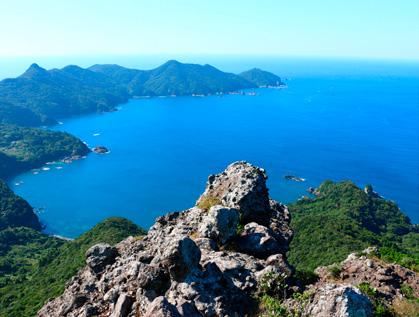
3 minute read
Eco Track

THE EIGHT COASTAL VIEWS OF Southern Kagoshima
Advertisement
Kagoshima Prefecture, at the southernmost tip of Kyushu Island, was called “Satsuma” during the feudal times before the 19th century. Minamisatsuma City sits on the most southwestern part of the Satsuma Peninsula. It has pristine nature, coastal trails and a pleasant, temperate climate throughout the year. The main attractions are the Fukiage Coast, one of the three largest sand dunes in Japan, and the stellar views of Minamisatsuma Kaido Hakkei (the Eight Coastal Views of Minamisatsuma).
Most people in Japan associate the name “Satsuma” with satsumaimo, the Japanese sweet potato. This region is known for delicious satsumaimo products and imo shochu , traditional distilled spirits made from grains, sweet potatoes and vegetables.
Minamisatsuma’s dramatic coastline and ocean views make it a popular cycling destination.
KAGOICHI CYCLING ROUTE
This 226-kilometer route is the longest Eco Track route in Minamisatsuma and makes one loop around the region. Start off at Cycling Terminal Rin Rin and head north along the coast for about two hours to Eguchi Horai-kan at Eguchi Fishing Port. Enjoy fresh seafood and delicious vegetables at this popular restaurant overlooking the East China Sea.
Cycle east towards Sakurajima, one of Japan's most active volcanoes and the symbol of Kagoshima. The volcano smokes constantly and minor eruptions take place multiple times a day. Sakurajima is located in the middle of Kagoshima Bay and is connected to land on the east so you can continue your cycle down to Arahira Tenjin, a scenic island shrine housing the god of learning.
To get back to Satsuma Peninsula, take a ferry from Nejime to Yamakawa terminal, and continue west to Banshobana Nature Park, where the Satsuma clan’s guardhouse was located for maritime security. Today it is a park with a promenade and observation deck.
The final leg of this journey stops at a series of observatories that make up the Minamisatsuma Kaido Hakkei Trail. Follow the coast west to Mitori Pass Observation Deck for a stunning sunrise. Further north, Marukizaki Observatory offers a panoramic view of the East China Sea and is a great spot to catch the sunset. From Ochimizu Observatory, you can see the Kame-ga-oka Cliff, a sheer rock wall naturally formed into the shape of a turtle.
The Kurose Observation Museum, which is also an art museum, opens up to a view of Okiakime Island and the rocky coastline, depicted in the artwork found in the museum. From Gohama Observatory, the sunset appears to loom over Cape Noma. Twenty-five minutes north, Taniyama Observatory offers a glimpse of the past as it overlooks terraced fields built in the latter half of the Edo Period. The final observatory before arriving back into town is Takasaki-yama, where you can see it all: Hashima-zaki, Eguchi Beach, Fukiage Beach, Sakurajima, Mt. Kinpu, Mt. Nagaya and the Sakinoyama Peninsula.
After cycling 90 minutes back into town, reward yourself with a hot bath at Kaseda Kaihin Onsen Yuuraku. The natural hot spring water is rich in minerals and said to relieve fatigue.
Getting There: It takes about 110 minutes from Haneda or Narita airports to Kagoshima Airport or 70 minutes from Kansai International Airport. From Kagoshima Airport, take the bus for Kaseda in central Minamisatsuma (75 minutes). Cycling Terminal Rin Rin, a bike rental facility and lodge, is a oneminute walk from Kaihin Onsen-mae Bus Stop.

Minamisatsuma

ABOUT JAPAN ECO TRACK
Montbell—Japan’s largest homegrown outdoor brand and retailer—started a series of events in 2009 called Sea to Summit. The goal was to invigorate local areas, holding events to experience nature through canoeing, cycling, trekking and other human-powered movement. While these events continue to be held in beautiful areas around Japan, the natural progression was to provide information and guides so travelers could experience these areas throughout the year at their own pace while learning the history and culture of the region and interacting with locals.
Japan Eco Track guides contain maps with designated routes of varying difficulty levels. Each guide includes information on local restaurants, guides, tour operations and other attractions. Along Japan Eco Track routes there are support stations located at affiliated stores and major transportation hubs such as train stations, airports and michi no eki (rest areas). Discounts and special offers are available at participating locations when travelers show the Japan Eco Track booklet. There are more than 15 guides, with new areas being developed and offered in English.



